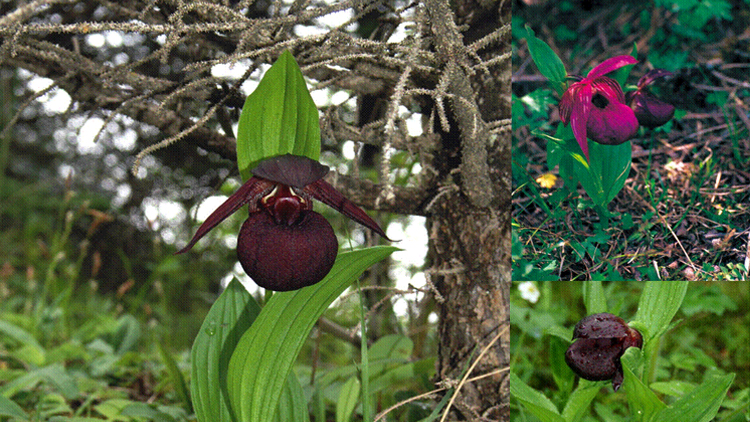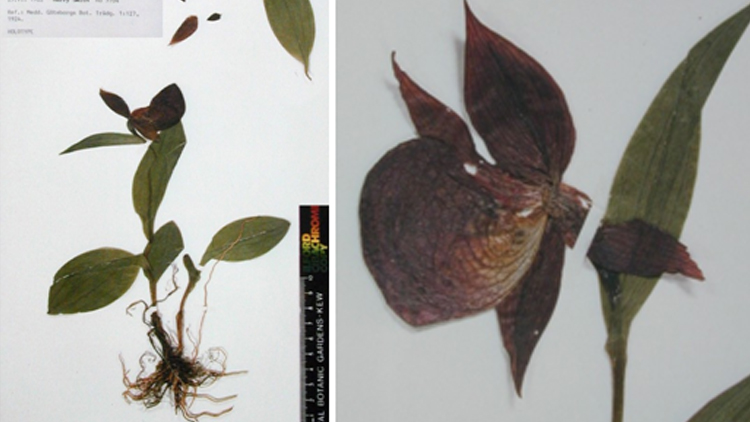Published in Särtyk ur Meddelanden från Göteborgs Botaniska Trädgård (Acta Horti Gothoburgensis) 1: 126. 1924. A synonym based on a type collected by Harry Smith in Huanglong valley on July 23, 1922, is Cypripedium smithii SCHLECHTER, 1924, published in Särtyk ur Meddelanden från Göteborgs Botaniska Trädgård (Acta Horti Gothoburgensis) 1: 129. 1924; non Cyp. Smithii Hort. ex B.S. Williams, Orchid Growers Manual ed. 7: 301. 1894.

This plant was known for some time as Cypripedium smithii Schlechter, 1924, but this name was already used and published 30 years earlier for the horticultural hybrid of Paphiopedilum lawrenceanum (Reichenbach f.) Pfitzer, 1888, with Paph. ciliolare (Reichenbach f.) Stein, 1892, published as Cypripedium Smithii Hort. ex B.S. Williams, 1894. In the 19t h century tropical slipper orchids of the genus Paphiopedilum were included in the genus Cypripedium. Despite the fact that the hybrid Cypripedium Smithii was validly registered as Cypripedium Lucie, the name Cyp. Smithii is a taxon first linked to the Paphiopedilum cross and cannot be used for the Cypripedium collected in Huanglong. However, Schlechter used a second specimen of the same species, also collected by H. Smith in the Huanglong valley on July 23, 1922, which was much smaller than the type of Cyp. smithii Schlechter, to describe Cyp. calcicolum, which is the legitimate name for the plant. Another synonym of Cyp. calcicolum is Cyp. taibaiense G. Zhu & S.C. Chen, 1999. Cyp. calcicolum grows in Huanglong in open shrub, often in grass or in a more or less dense herb layer. It can be found in the Huanglong valley between 3100-3300 m and further down in the national park between 2450-2950 m. It can be differentiated from the similar Cypripedium tibeticum King ex Rolfe by the narrower and more acute petals, the wider opening of the lip, the flat upper surface of the lip which abruptly curves down at the front to form the deeply saccate slipper, sometimes prominent translucent windows at the base of the slipper and the usually narrower and more yellowish leaves that are attached in the lower third of the stem. The bumble bee Bombus hypnorum, also pollinating Cyp. tibeticum, was found to be the pollinator of Cyp. calcicolum and hybrids between the two orchid species occur in the wild. The dark plum-color of the flower, caused by a yellow to ivory basal coloration superposed by red anthocyanin, is typical for Cyp. calcicolum but is shared with populations of Cypripedium tibeticum to which the synonym Cypripedium corrugatum Franchet, 1894, is sometimes applied. The lack of a white collar around the lip opening in Cyp. calcicolum is also a character shared with many forms of Cyp. tibeticum. Cyp. calcicolum is 15-35 cm tall and the single flower is 5-9 cm across.

杓兰曾经被认为褐花杓兰Cypripedium smithii Schlechter, 1924。但褐花杓兰的种加词smithii已经在1894年被用于兜兰属的一个园艺杂交种。在19世纪,产自热带的兜兰属植物是包含在杓兰属中的。因此该兜兰的杂交种是以杓兰属的属名进行登记的,褐花杓兰是第一个与兜兰属杂交种有联系的杓兰属植物。不管怎样, 褐花杓兰的种加词smithii不应用于黄龙采集的杓兰植物。鲁道夫 • 施勒希特1924年将哈里 • 史密斯1992年7月23日在黄龙沟采集的同一物种的第二份标本描述为杓兰,该标本上的植株比褐花杓兰的模式标本要小得多。因此,杓兰应该是这种植物的合法名称。杓兰的另一个同物异名为太白杓兰Cyp. taibaiense G. Zhu & S.C. Chen, 1999。在黄龙沟,杓兰通常生长在海拔3100-3300米的开旷灌丛中,草地或比较茂密的草层中。在黄龙国家公园杓兰分布的海拔可以更低些,在2450-2950米的地方也可生长。杓兰植株体态和花的构造很接近西藏杓兰,但杓兰花瓣比较狭窄,先端较尖,唇瓣开口较大,唇瓣上表面较平坦,但它向前急剧弯曲成较深的拖鞋状(深囊状)。有时拖鞋(唇瓣)基部具明显的透明网格,狭窄的叶片与较低的茎相连(叶片从茎的第三节长出)。花朵通常为紫黑色,这是它的典型特征。但西藏杓兰一些居群也有类似特征。杓兰的囊口没有白色环,西藏杓兰的很多类型的花也没有白色环。杓兰植株高度通常为15-35厘米,花单朵,直径一般是5-9厘米。